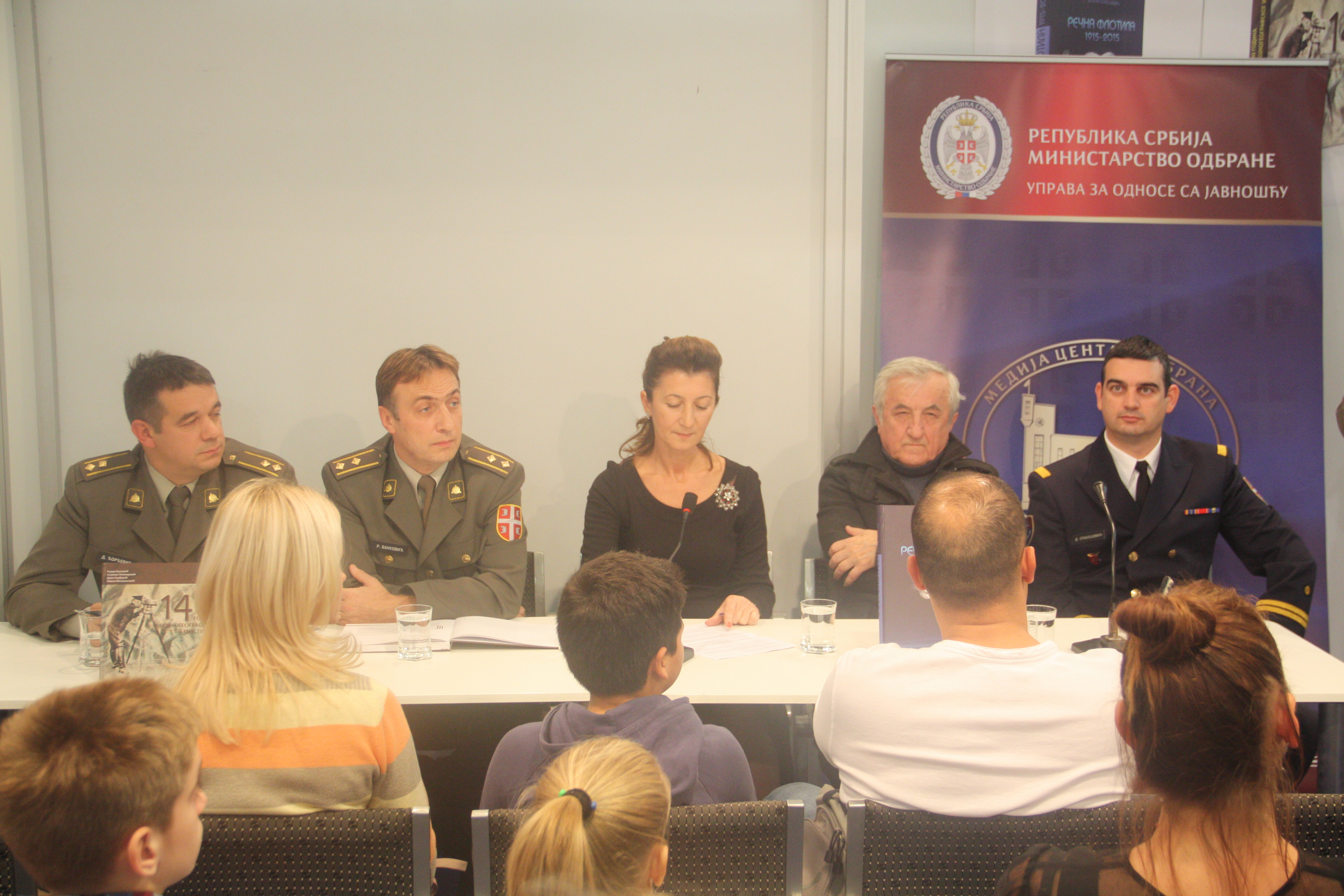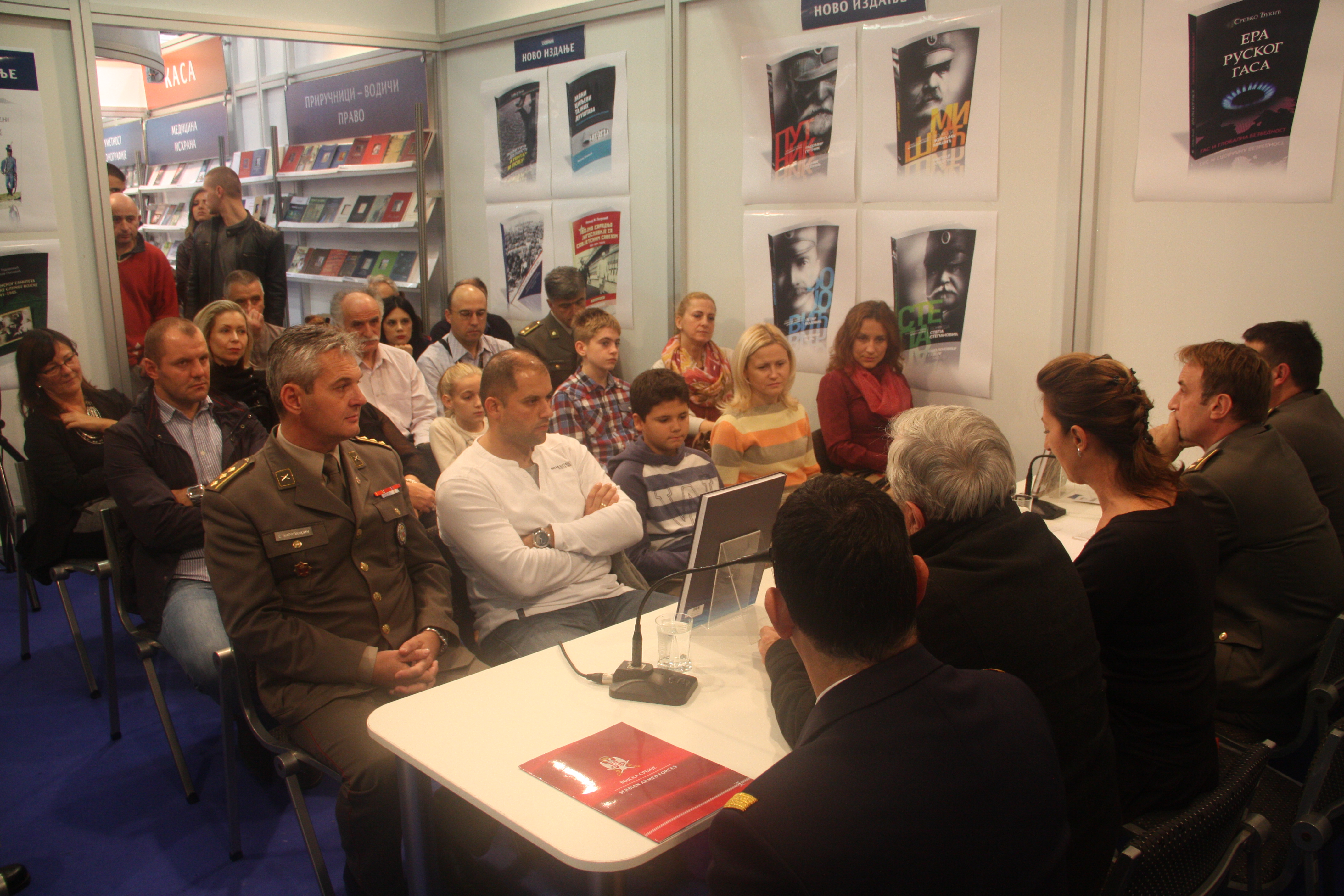29.10.2016
Saturday at the Book Fair
 On the seventh day of the Fair, two new books were promoted at the Odbrana Media Centre stand – ‘140 years of Military Geography Institute’ and ‘The River Flotilla 1915-2015’. In his introductory address, the Director of Odbrana Media Centre informed those present about the publishing policy of that establishment and emphasised that some hundred books are published each year, out of which a quarter is intended for wider reading audience. This year, small book promotions were organised for 15 books. Most these works mark significant anniversaries.
On the seventh day of the Fair, two new books were promoted at the Odbrana Media Centre stand – ‘140 years of Military Geography Institute’ and ‘The River Flotilla 1915-2015’. In his introductory address, the Director of Odbrana Media Centre informed those present about the publishing policy of that establishment and emphasised that some hundred books are published each year, out of which a quarter is intended for wider reading audience. This year, small book promotions were organised for 15 books. Most these works mark significant anniversaries.The monographs promoted today were presented first by Mirjana Sandic, the editor of these publications. The book ‘The River Flotilla 1915-2015’, by Rear Admiral (retired) Bosko Antic and Lieutenant (Navy) Dragan Spasojevic, as she pointed out, is a testimony of a significant contribution made by the members of the River Flotilla in the struggle for the liberation of the country in 20th century, which is still insufficiently known fact. It is richly illustrated and depicts the life of the members of the River Flotilla and it is a true witness of the path of development of this military branch. According to her words, the book represented an encyclopaedic edition containing chronologic order of events, tactical and technical data on river vessels, assets and equipment of river units that were in service from the establishment until today.
One of the authors, Bosko Antic, this being his 55th book, underlined that writing this monograph was his debt to the unit in which he had started his military career choosing the garrison as the first in rank of the 18th class. It was there that he spent 14 most beautiful years of his life and, as he said, the River Flotilla had been his love for 49 years. He spoke about the history of the River Flotilla, its long tradition – starting from the famous “Sajkasi“. He said that in all the wars, the River Flotilla executed its tasks, unlike other units in the Adriatic sea, which had not discharged their duties and where treason was commonplace.
Lieutenant (Navy) Dragan Spasojevic said that he and Rear Admiral Antic managed to consolidate in three years everything that was diversely written by authors throughout different epochs. The two just assembled a mosaic. Spasojevic told an anecdote about how a friend had asked him how long it had taken them to write the book and he jokingly retorted: “a hundred years”
 - He thought that I was joking, but he quickly understood my answer – throughout its existence, the River Flotilla has been writing and wrote the pages of its history, leaving the traces and the mark of its existence behind, and in that case the signed authors of the book was given a chance to steal a part of the past from oblivion.
- He thought that I was joking, but he quickly understood my answer – throughout its existence, the River Flotilla has been writing and wrote the pages of its history, leaving the traces and the mark of its existence behind, and in that case the signed authors of the book was given a chance to steal a part of the past from oblivion.The Lieutenant emphasised that the monograph is a witness of a constant struggle and numerous accounts of heroism and bravery of sons of our freedom loving people. He stressed: “We have dedicated it to our predecessors crowned by glory, the ones who were better than us: to Serbian Sajkasi of Sajkas battalion, the warriors of Shipping Command, boatmen and sailors of Yugoslav Royal Navy, members of Partisan Navy Company and River Flotilla, to the ones who perished defending the freedom of river.
At the end, Spasojević reminded that on 31st October, the River Flotilla celebrates St. Luka as the unit’s saint, in the memory of the day in 1918, when Belgrade was liberated and Serbian tricolour was raised on a seized Austro-Hungarian monitor “Bodrog”, the very boat from whose deck shelling had been launched on that capital of the Kingdom of Serbia initiating the First World War.
The book ‘140 Years of Military Geographic Institute’ was promoted at the Book Fair by Lieutenant Colonel Radoje Bankovic, PhD, Slaviša Tatomirovic, MA, Lieutenant Colonel Dejan Djordjevic and Major Marko Milasinovic. The editor of the book was Mirjana Sandic who said presenting the book that the monograph was printed to mark 140 years of the existence of that institution – from the establishment of the Second Geographic Division to the Military Geography Institute – and that it followed the development of that establishment since the period when it printed first topographic maps until today when it produces digital geodetic maps. She underscored that the great wealth of the MGI is reflected in immeasurable treasure of the maps archive and its other products.
As early as late 19th and the beginning of 20th century Serbia was educating personnel in geodesy for military and civilian purposes and was a member of the most significant international geodetic societies and associations. All this sufficiently testifies to the importance that Serbia and its military attached to geodetic service and cartography as Mirjana Sandic explained.
One of the authors, Lieutenant Colonel Radoje Bankovic, PhD, presented the contents of the book. He said that two books so far shed light on certain periods, but never until now was it written so comprehensively about the MGI. The monograph of more than 220 pages, richly illustrated by photographs, represents the “first” 140 years of the MGI, an establishment which deals with research and development and production work in the fields of geodesy, photogrammetry, cartography, geographic information systems, cartographic reproduction, metrology and other geo-disciplines.
He noted that in the book, one can read about who the Heads leading the Institute were, where the company was located both in peace and war time, and of course where it is situated today. It talks about maps produced in the past period, and it also provides a vision of development and the way ahead that the Institute will follow. He pointed out that since 1945 until 2016, colleagues from the MGI wrote 44 MSc theses and 25 doctoral dissertations.
At the end he said that, while deciding which map among some tens of million maps that exist in the MGI, should be given in the attachment, they had decided to present a section of a map 1: 75,000 which, at one time, captains produced and later Serbian Field Marshals introduced it as mandatory practice prerequisite for the advancement in service.
Speaking about how important the MGI was to them he pointed out:
- The history of this institution spans three centuries and during that period it existed in eight states, it changed its location and had different names. It was situated in several locations two of them being in Belgrade.
After that Lieutenant Colonel Dejan Djordjevic spoke about the monograph and reminded that at one time the production of maps had been a long and painstaking process, and that today it was easy to do it since they possess the state of the art equipment – the air photo images are used as a basic source of data and they possess the most modern equipment, a new aeroplane, airphoto camera, software, hardware. However, according to Djordjevic, all that could never be possible to use without the knowledge and experience of people who are the greatest treasure of the MGI.
 PHOTOGALLERY
PHOTOGALLERY
